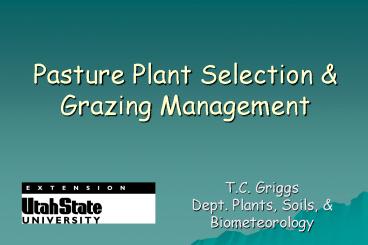Pasture Plant Selection - PowerPoint PPT Presentation
1 / 24
Title:
Pasture Plant Selection
Description:
Pasture Plant Selection & Grazing Management T.C. Griggs Dept. Plants, Soils, & Biometeorology Adapted pasture species -- Grasses Orchardgrass Tall fescue ... – PowerPoint PPT presentation
Number of Views:26
Avg rating:3.0/5.0
Title: Pasture Plant Selection
1
Pasture Plant Selection Grazing Management
- T.C. GriggsDept. Plants, Soils, Biometeorology
2
Environment site conditions
Availability of soil surveys http//soils.usda.go
v
3
NRCS, Bozeman, MT
4
Alfalfa,white clover, red clover
5
Adapted pasture species
- -- Grasses
- Orchardgrass
- Tall fescue
- Bromegrasses
- Ryegrasses
- Wet meadowland grasses
- Kentucky bluegrass
- Wheatgrasses
- Wildryes
- -- Legumes
- White clover
- Red clover
- Alfalfa
- Birdsfoot trefoil (NB)
- Cicer milkvetch (NB)
- Sainfoin (NB)
- Alsike clover
- Strawberry clover
6
Wet meadowland grasses
- Timothy
- Reed canarygrass
- Creeping foxtail
- Meadow foxtail
7
Basic grasses for Utah pastures
- Irrigated Tall fescue (endophyte-free) Meadow
brome Orchardgrass - Dryland Smooth bromegrass Intermediate/pubescen
t wheatgrass Thickspike/streambank
wheatgrass Crested or Siberian
wheatgrass Russian wildrye
8
Species with more defoliation tolerance/rapid
recovery
- Orchardgrass
- Tall fescue
- Meadow brome
- Perennial Italian ryegrasses
- Kentucky bluegrass
- Creeping meadow foxtails
- Crested Siberian wheatgrasses
- White clover
- Red clover
9
Species with less defoliation tolerance/slower
recovery
- Smooth brome
- Timothy
- Reed canarygrass
- Intermediate pubescent wheatgrasses
- Quackgrass
- Bluebunch wheatgrass
- Warm-season perennial grasses
- Alfalfa
- Birdsfoot trefoil
10
Forage plant information resources
- Comparative Characteristics of Forage Species in
Montanahttp//animalrangeextension.montana.edu/Fo
rage/forage.htm - Plant Guides Fact Sheets in USDA NRCS National
PLANTS databasehttp//plants.usda.gov/index.html
- Intermountain Planting Guide. USU Extension
Publication AG 510.
11
How many grasses can remain productive compete
with weeds when grazed this closely?
12
Pasture plant requirements
- Green leaf area for sunlight capture, or energy
reserves to support regrowth - In grasses, energy reserves are above ground in
stubble - Maintain stubble through winter for survival
spring recovery - Roots require energy from shoots in order to
absorb water nutrients to potential
13
Vegetative shoot (where is the apicalmeristem?)
New tiller (shoot) stack of phytomers from a bud
14
Reproductive shoot Shift in status of shoot
apex Internode elongation creates true stem
15
Manage reserves or retain some leaf area
16
Orchardgrass, 30 hr
17
Timothy, 10 days
18
Residual leaf area growing points How much
height or pasture mass to leave?
19
Impact of defoliation on root depth function
20
Targets monitoring
- Animal performance
- Herbage mass maturity stage
- Amounts to graze, stockpile, or conserve
- Pasture growth rate
- Residual leaf area or stubble
- Soil water nutrient status
- Weeds
- Market conditions
21
Seasonal carrying capacity
Annual forage prod.
Seasonal utilization level
x
Length of grazing season
Average daily intake
x
22
Grazing systems
- Continuous stocking livestock have access to
entire pasture all of the time. Potentially
higher individual animal performance. - Rotational stocking livestock are moved through
a series of subdivisions (paddocks) which are
grazed rested. Potentially higher carrying
capacity.
23
Rotational stocking dry lot
NRCS, Bozeman, MT
24
General guidelines
- Initiate grazing when plants are 6-10 in. tall
- Limit grazing in a paddock to no more than 7 days
- Terminate grazing when stubble is 3-4 in. tall
- Allow at least 14-28 days regrowth































